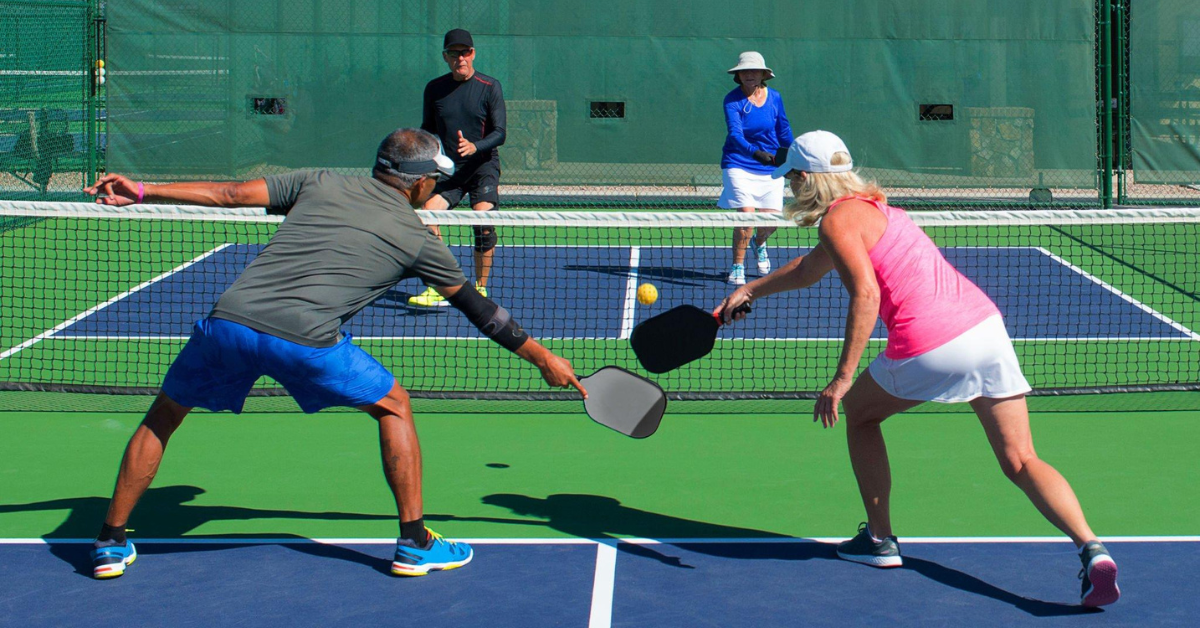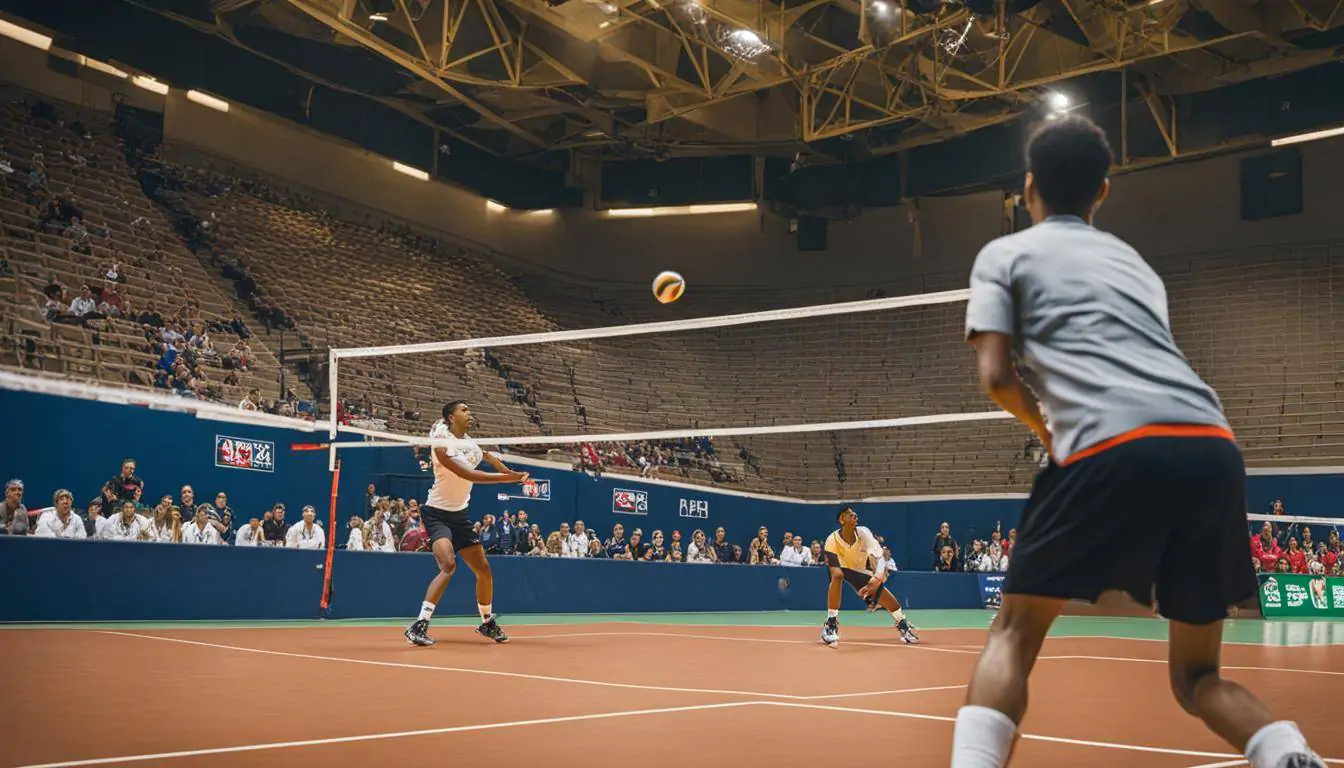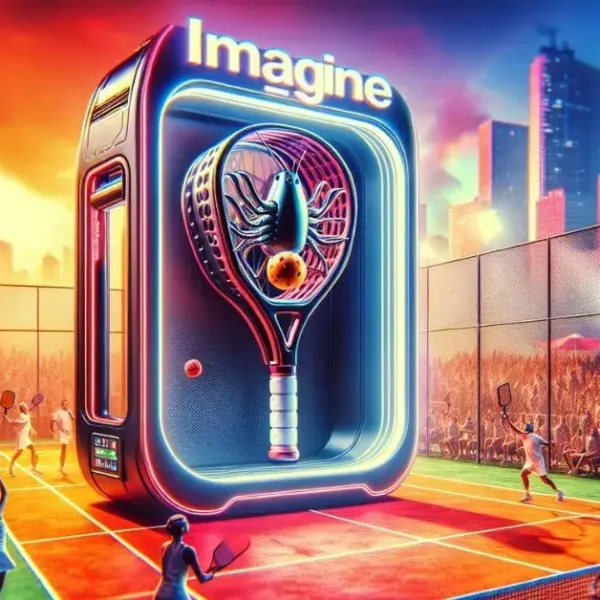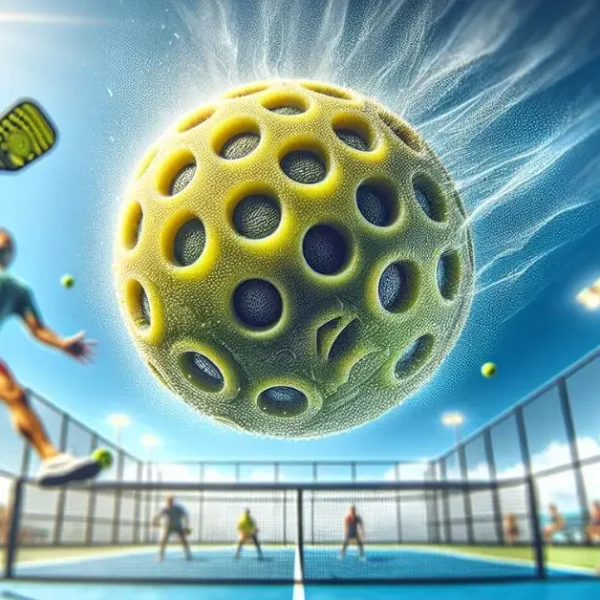7 Basic Pickleball Strategy
Pickleball is not just a game of hitting the ball back and forth. It also requires some strategy and tactics to win points and matches. In this article, we will share with you some basic pickleball strategy that can help you improve your game and have more fun on the court. Whether you are a beginner or an intermediate player, these tips will help you play smarter, not harder.
1. Get your team to the net ASAP!
One of the most important pickleball strategy is to get your team to the net as soon as possible. The net is the best position to control the game and put pressure on your opponents. When you are at the net, you can hit more angles, volleys, and putaways, and you can also cover more of the court. You also force your opponents to hit harder and higher shots, which gives you more opportunities to attack.
The best way to get to the net is to hit a deep and low serve and return of serve. This will push your opponents back and give you time to move forward. You should also avoid hitting high and short shots that allow your opponents to approach the net. If you are stuck at the baseline, you should try to hit a deep and soft shot that lands in the no-volley zone, also known as the kitchen. This will force your opponents to hit up and give you a chance to move in.
2. Improve your Pickleball Serve
The serve is the first shot of every point, and it can set the tone for the rest of the rally. A good serve can give you an advantage and put your opponents on the defensive. A bad serve can give away easy points and put you on the back foot.
To improve your pickleball serve, you should focus on three aspects: placement, power, and spin. Placement is the most important, as you want to hit the serve to the weakest or most uncomfortable spot of your opponent. For example, you can aim for their backhand, their body, or the corners of the court. Power is also important, as you want to hit the serve with enough speed and force to make it difficult for your opponent to return. However, you should not sacrifice accuracy or consistency for power. Spin is the least important, but it can add some variety and unpredictability to your serve. You can use topspin, backspin, or sidespin to make the ball bounce differently and throw off your opponent’s timing.
3. Play smarter, NOT harder
Pickleball is a game of skill, not strength. You do not need to hit the ball hard to win points. In fact, hitting the ball hard can often backfire, as you can make more errors, lose control, and tire yourself out. Instead, you should play smarter, not harder. This means using finesse, placement, and patience to outsmart and outplay your opponents.
One of the best ways to play smarter is to use the dink shot. The dink shot is a soft and low shot that lands in the kitchen. The dink shot is a great way to neutralize your opponent’s power and force them to hit up. It also allows you to maintain your position at the net and wait for a high ball to attack. The dink shot is especially effective against aggressive players who like to hit hard and fast.
Another way to play smarter is to use the lob shot. The lob shot is a high and deep shot that goes over your opponent’s head and lands near the baseline. The lob shot is a great way to change the pace and direction of the game and catch your opponent off guard. It also allows you to reset the point and get back to the net. The lob shot is especially effective against players who are too close to the net or too slow to move back.
4. Return of Serve Strategy
The return of serve is the second shot of every point, and it can determine the outcome of the rally. A good return of serve can put you in an offensive position and force your opponent to hit a weak shot. A bad return of serve can put you in a defensive position and give your opponent an easy shot to attack.
To improve your return of serve, you should focus on three aspects: depth, direction, and speed. Depth is the most important, as you want to hit the return of serve as deep as possible, preferably near the baseline. This will push your opponent back and give you time to move to the net. Direction is also important, as you want to hit the return of serve to the opposite side of where your opponent is standing. This will make them move and hit a cross-court shot, which is longer and harder to execute. Speed is the least important, but it can add some pressure and variation to your return of serve. You can use a fast or slow return of serve to surprise your opponent and disrupt their rhythm.
5. 3rd Shot Strategy
The 3rd shot is the third shot of every point, and it is usually hit by the serving team. The 3rd shot is a crucial shot, as it can determine whether you can get to the net or not. The 3rd shot is also a challenging shot, as you have to hit it from the baseline, over the net, and into the kitchen, while your opponents are waiting at the net to attack.
To improve your 3rd shot, you have two main options: the 3rd shot drop or the 3rd shot drive. The 3rd shot drop is a soft and low shot that lands in the kitchen. The 3rd shot drop is a great way to neutralize your opponent’s net position and force them to hit up. It also allows you to move to the net and join your partner. The 3rd shot drive is a hard and flat shot that goes past your opponent’s paddle. The 3rd shot drive is a great way to catch your opponent off guard and create an opening. It also allows you to move to the net and follow your shot.
The best 3rd shot strategy depends on several factors, such as your skill level, your opponent’s skill level, your opponent’s position, and the ball’s height and speed. In general, you should use the 3rd shot drop more often than the 3rd shot drive, as it is safer and more effective. However, you should also mix in some 3rd shot drives to keep your opponent guessing and prevent them from camping in the kitchen.
6. Your 4th Shot
The 4th shot is the fourth shot of every point, and it is usually hit by the returning team. The 4th shot is an important shot, as it can determine whether you can maintain your net position or not. The 4th shot is also a difficult shot, as you have to hit it from the kitchen, over the net, and into the kitchen, while your opponents are also at the net and ready to volley.
To improve your 4th shot, you have two main options: the 4th shot dink or the 4th shot volley. The 4th shot dink is a soft and low shot that lands in the kitchen. The 4th shot dink is a great way to continue the dink rally and wait for a high ball to attack. It also allows you to stay at the net and keep your opponent at bay. The 4th shot volley is a hard and fast shot that goes past your opponent’s paddle. The 4th shot volley is a great way to end the point and win the rally. It also allows you to stay at the net and put pressure on your opponent.
The best 4th shot strategy depends on several factors, such as your skill level, your opponent’s skill level, your opponent’s position, and the ball’s height and speed. In general, you should use the 4th shot dink more often than the 4th shot volley, as it is safer and more consistent. However, you should also mix in some 4th shot volleys to take advantage of any high or weak balls and finish the point.
7. Communication is key!
Pickleball is a team sport, and communication is key to success. Communication can help you and your partner coordinate your movements, shots, and strategies. Communication can also help you avoid confusion, collisions, and errors.
To improve your communication, you should use clear and simple words and signals to communicate with your partner. For example, you can use words like “mine”, “yours”, “switch”, “poach”, or “no” to indicate who will take the ball, when to change sides, when to intercept the ball, or when to let the ball go out. You can also use signals like pointing, nodding, or raising your paddle to indicate where you will serve, where you will return, or what shot you will hit. You should also communicate before, during, and after each point to plan your strategy, encourage each other, and celebrate your wins.
Basic Things to Consider while Following Strategy
Before you apply any of the basic pickleball strategy mentioned above, you should also consider some basic things that can affect your game and performance. These are:
Pickleball Court and Equipment
The pickleball court and equipment can vary depending on where you play and what you use. The pickleball court is usually 20 feet by 44 feet, with a net height of 36 inches at the sidelines and 34 inches at the center. The no-volley zone, or the kitchen, is a 7-foot area on both sides of the net where you cannot hit the ball in the air. The pickleball paddle is usually made of wood, composite, or graphite, and it has a maximum length of 17 inches and a maximum width of 8.5 inches. The pickleball ball is usually made of plastic, and it has 26 to 40 holes. The ball can be either indoor or outdoor, depending on the surface and weather conditions.
You should familiarize yourself with the pickleball court and equipment before you play, and make sure they are in good condition and meet the official standards. You should also choose the paddle and ball that suit your style and preference, and that are comfortable and durable. You should also check the weather and wind conditions, and adjust your shots accordingly.
Pickleball Rules
The pickleball rules are the basic guidelines that govern the game and ensure fair play. The pickleball rules cover topics such as scoring, serving, faulting, and etiquette. You should know and follow the pickleball rules before you play, and respect the decisions of the referee and your opponents. You should also learn the common terms and signals used in pickleball, such as “side out”, “let”, “foot fault”, or “kitchen violation”.
Some of the most important pickleball rules are:
- The game is played to 11 points, and you must win by 2 points.
- You can only score when you are serving, and you can only serve underhand and diagonally.
- You must let the serve bounce once before you return it, and you must let the return bounce once before you hit it. This is called the two-bounce rule.
- You cannot hit the ball in the air when you are in the kitchen, unless the ball bounces in the kitchen first. This is called the no-volley rule.
- You cannot touch the net, the ball, or the court with your paddle, body, or clothing during a rally. This is called a fault.
Pickleball Scoring System
The pickleball scoring system is the method of keeping track of the points and games in a match. The pickleball scoring system can be confusing for beginners, as it involves three numbers: the server’s score, the receiver’s score, and the server’s number. You should learn and practice the pickleball scoring system before you play, and announce the score clearly and loudly before each serve.
The pickleball scoring system works as follows:
- Each team has two servers, except at the beginning of the game, when the first team has only one server.
- The server’s score is always announced first, followed by the receiver’s score, followed by the server’s number (either 1 or 2).
- The server’s number indicates which player is serving on each team. The player on the right side of the court is the first server, and the player on the left side of the court is the second server.
- The server’s number changes only when the serving team wins a point, or when the first server loses the serve at the beginning of the game.
- The server’s number does not change when the serving team loses the serve, or when the second server loses the serve at any time.
- The serving team switches sides after winning a point, and the receiving team switches sides after winning the serve.
- The game ends when one team reaches 11 points and has a 2-point lead over the other team.
Pickleball Strategies for Singles and Doubles
Pickleball can be played as singles or doubles, and each format has its own strategies and tactics. You should learn and practice the pickleball strategies for singles and doubles before you play, and choose the format that suits your skill level and preference.
Some of the main differences between singles and doubles are:
- In singles, you have to cover the whole court by yourself, and you have to hit more shots and run more. In doubles, you have to share the court with your partner, and you have to hit fewer shots and run less.
- In singles, you have to hit more offensive and aggressive shots, and you have to aim for the corners and sidelines. In doubles, you have to hit more defensive and cooperative shots, and you have to aim for the middle and the feet.
- In singles, you have to serve and return more often, and you have to use more variety and spin. In doubles, you have to serve and return less often, and you have to use more depth and consistency.
- In singles, you have to play more strategically and tactically, and you have to adapt to your opponent’s style and weakness. In doubles, you have to play more communicatively and harmoniously, and you have to coordinate with your partner’s style and strength.
Basic Pickleball Techniques – Serve, Return, Dink, and Smash
Pickleball involves four basic techniques that are essential for any player: the serve, the return, the dink, and the smash. You should master these basic pickleball techniques before you play, and practice them regularly and correctly.
The serve is the first shot of every point, and it can give you an advantage or a disadvantage. To execute a good serve, you should:
- Stand behind the baseline and face the court diagonally.
- Hold the paddle in a comfortable and relaxed grip, and swing it from low to high in a smooth and fluid motion.
- Hit the ball with the center of the paddle, and aim for a deep and low spot on the opposite court.
- Follow through with your paddle and body, and move to the center of the court.
The return is the second shot of every point, and it can determine the outcome of the rally. To execute a good return, you should:
- Stand near the baseline and face the court diagonally.
- Hold the paddle in a ready and alert position, and watch the ball and your opponent closely.
- Hit the ball with the center of the paddle, and aim for a deep and low spot on the opposite court.
- Follow through with your paddle and body, and move to the net.
The dink is a soft and low shot that lands in the kitchen, and it can neutralize your opponent’s power and force them to hit up. To execute a good dink, you should:
- Stand near the net and face the court squarely.
- Hold the paddle in a soft and gentle grip, and swing it from high to low in a short and controlled motion.
- Hit the ball with the face of the paddle, and aim for a low and soft spot in the kitchen.
- Follow through with your paddle and body, and stay at the net.
The smash is a hard and fast shot that goes past your opponent’s paddle, and it can end the point and win the rally. To execute a good smash, you should:
- Stand near the net and face the court squarely.
- Hold the paddle in a firm and strong grip, and swing it from high to low in a long and powerful motion.
- Hit the ball with the edge of the paddle, and aim for a high and fast spot on the opposite court.
- Follow through with your paddle and body, and stay at the net.
Advanced Pickleball Techniques – Lob, Drop Shot, and Spin
Pickleball also involves some advanced techniques that can add some variety and unpredictability to your game: the lob, the drop shot, and the spin. You should learn and practice these advanced pickleball techniques before you play, and use them sparingly and wisely.
The lob is a high and deep shot that goes over your opponent’s head and lands near the baseline, and it can change the pace and direction of the game and catch your opponent off guard. To execute a good lob, you should:
- Stand near the net and face the court squarely.
- Hold the paddle in a loose and flexible grip, and swing it from low to high in a slow and smooth motion.
- Hit the ball with the face of the paddle, and aim for a high and deep spot on the opposite court.
- Follow through with your paddle and body, and move back to the baseline.
The drop shot is a low and short shot that lands near the net, and it can create an opening and force your opponent to move forward. To execute a good drop shot, you should:
- Stand near the baseline and face the court diagonally.
- Hold the paddle in a soft and gentle grip, and swing it from high to low in a short and controlled motion.
- Hit the ball with the face of the paddle, and aim for a low and short spot on the opposite court.
- Follow through with your paddle and body, and move to the net.
The spin is a technique that makes the ball bounce differently and throw off your opponent’s timing. You can use topspin, backspin, or sidespin to create different effects. To execute a good spin, you should:
- Hold the paddle in a comfortable and relaxed grip, and swing it in a circular or diagonal motion.
- Hit the ball with the side or the bottom of the paddle, and brush it with a slight angle.
- Aim for a spot on the opposite court that matches the direction of your spin.
- Follow through with your paddle and body, and move to the appropriate position.
Pickleball Etiquettes and Safety Tips
Pickleball is not only a sport, but also a social activity that involves respect, courtesy, and fun. You should follow some pickleball etiquettes and safety tips before, during, and after you play, and enjoy the game with your friends and opponents.
Some of the pickleball etiquettes and safety tips are:
- Be friendly and polite to your partner, your opponents, and other players on the court. Greet them, introduce yourself, shake hands, and compliment them on their good shots.
- Follow the rules and the scoring system of the game, and respect the calls and decisions of the referee and your opponents. If there is a dispute or a doubt, replay the point or give the benefit of the doubt to your opponents.
- Wait until the end of the point or the game to talk to your partner or your opponents. Do not distract, interrupt, or interfere with the play. Do not make loud noises, gestures, or comments that can affect the concentration or the mood of the players.
- Be aware of your surroundings and the other players on the court. Do not walk or run across the court when a game is in progress. Do not hit the ball or the paddle at anyone or anything. Do not throw or slam your paddle or the ball in frustration or anger.
- Have fun and enjoy the game. Do not take the game too seriously or personally. Do not argue, complain, or blame anyone for the outcome of the game. Do not boast, mock, or criticize anyone for their performance or skill level. Do not cheat, lie, or manipulate the game in your favor.
- Wear appropriate and comfortable clothing and shoes that suit the weather and the surface conditions. Wear protective gear such as sunglasses, hat, sunscreen, and water bottle to prevent sunburn, dehydration, and heatstroke. Wear a wristband, a glove, or a tape to prevent blisters, cuts, and injuries on your hand.
- Warm up and stretch before and after you play. Do some light exercises and movements to prepare your muscles, joints, and heart for the game. Do some cool down and relaxation exercises to ease your muscles, joints, and heart after the game.
- Drink plenty of water and fluids before, during, and after you play. Stay hydrated and replenish your electrolytes and energy levels. Avoid alcohol, caffeine, and sugary drinks that can dehydrate you and affect your performance and health.
- Eat healthy and balanced meals and snacks before, during, and after you play. Eat foods that are rich in carbohydrates, proteins, and fats to fuel your body and mind. Avoid foods that are spicy, greasy, or heavy that can upset your stomach and digestion.
- Rest and recover after you play. Take a nap, a shower, or a massage to relax your body and mind. Apply ice, heat, or cream to soothe your sore muscles, joints, and injuries. Consult a doctor, a trainer, or a therapist if you have any pain, discomfort, or problem that persists or worsens.
Final Thoughts
Pickleball is a wonderful sport that can bring you many benefits and joys. It can improve your physical, mental, and social well-being, and it can challenge you and entertain you. However, pickleball is not just about hitting the ball and winning the game. It is also about following some basic pickleball strategy that can help you play better and have more fun. By applying these tips and tricks, you can enhance your skills, tactics, and techniques, and you can also enjoy the game with your friends and opponents. We hope you found this article helpful and informative, and we hope you will try out some of these basic pickleball strategy in your next game. Happy pickleballing!




